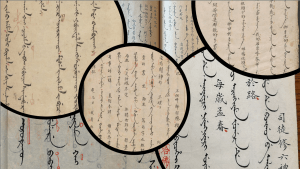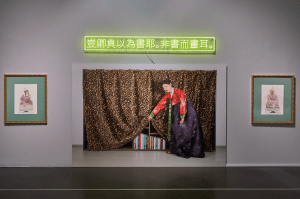Please join us next Wednesday, May 15, at 4:45-6:45pm CT, CWAC 152 for our next and very last VMPEA workshop of the academic year, co-sponsored with DoVA’s Open Practice Committee. This workshop features:
Reiko Tomii
Independent Art Historian and Curator
Who will be presenting the talk titled:
“Thinking Operationally”
Discussant: Tongji Philip Qian
Artist and Collegiate Assistant Professor, Department of Visual Arts, UChicago
This workshop will take place in-person only. Please see the abstract and bios for this workshop below.
We hope to see many of you there before the year ends!

Image Credit: Courtesy of Misa Shin Gallery, Tokyo.
Abstract/Statement
The twin-book project that I launched in late 2022, “Thinking Operationally,” centers on the concept of “operation” as an integral part of art history. My starting point is a new definition of an artist labor, which in my definition consists of two parts, “expression” and “operation.” While the first type of labor, “expressions,” typically takes place inside the artist’s studio, the second type of labor, “operations,” concerns making their work public and, when necessary, building systems to support themselves and engage society outside the studio. By extension, I define “operation,” either by the artist and others, as a set of activities that generate channels or circuits through which the artist’s expression is communicated to society at large.
This view emerged from my close study of collectivism in modern Japan, which dates back to the last 19th century and continued into the 21st century. In fact, Japan serves as a counter reference point to the Euro-American idea of artistic autonomy, because artists’ group activities have been essential for advancing new art and for building new art systems in modern Japan.
Based on this conceptualization, I have envisioned the two-book project. The first is a one-year plan to write a small book, titled “Thinking Operationally,” in Japanese to outline the theoretical import of “operations” in modern Japan and examine seven topics including Gutai, artist-organized independent exhibitions, and Tokyo Biennale 1970. For this part, I have a publisher confirmed (East Press in Tokyo) and I am in the process of completing the first draft. The second is a five-year plan to follow the first, for which I am planning an English-language survey of 1960s art in Japan which will reconsider the role and place of “operation” by focusing on the exhibition history. Provisionally titled “Exhibition as Expression, Exhibition as Operation,” the book will explore the exhibitions as the vital site of communication and socialization of expression for artists as much as curators and museums. In doing so, the book will illuminate the crucial postwar decade when Japan’s contemporary art rapidly expanded in a dual drive of both a top-down push of institutionalization in the mainstream and a bottom-up urgency of the wilderness.
Bios
Reiko Tomii is an independent scholar and curator specializing in postwar Japanese art history. In 1988–92, she worked at the Center for International Contemporary Art (CICA), where her first project involved organizing a personal archive of Kusama Yayoi for CICA’s inaugural exhibition. Kusama’s first retrospective in the U.S. in 1989, for which Tomii collaborated with Alexandra Munroe, brought the Japanese artist back to New York and in retrospect launched Kusama’s ascendance to global super stardom. Since 1992, upon the closure of CICA, Tomii has worked as independent scholar. She collaborated with Munroe on the latter’s book published in conjunction with the exhibition Japanese Art After 1945: Scream Against the Sky.
Curatorially, she worked with Queens Museum of Art in New York for Global Conceptualism, Tate Modern in London for Century City, and Getty Research Institute in Los Angeles for Art, Anti-Art, Non-Art, among many others. While widely published in the area of modern and contemporary Asian art, she has enjoyed working with younger and emerging scholars, and co-founded PoNJA-GenKon with Miwako Tezuka in 2003.
Tomii’s first monograph Radicalism in the Wilderness: International Contemporaneity and 1960s Art in Japan (MIT Press, 2016) received the 2017 Robert Motherwell Book Award and was turned into an exhibition Radicalism in the Wilderness: Japanese Artists in the Global 1960s at Japan Society Gallery in New York in 2019. In 2020, she received the Commissioner for Cultural Affairs Award from the Japanese government for cultural transmission and international exchange through postwar Japanese art history.
She is currently preparing for the publication of her second monograph, Thinking Operationally: Toward a Global Narration of Japanese-Type Modernism. Published by East Press in Tokyo, the book is her first monograph in Japanese and will serve as the foundation of her third monograph, to be published in English, provisionally titled, Exhibition as Expression, Exhibition as Operation: Japanese Art in the 1960s and 1970s.
Tongji Philip Qian is a multidisciplinary artist and the co-founder of TPQ Studio. As artist, he is interested in capturing the edge of an artistic practice through his idiosyncratic definitions of #speed, #labor, #internationalism, and #immigration. His art writing, on the other hand, studies movements commonly associated with Minimalism, Post-Minimalism, and Conceptual art. Tongji Philip Qian’s recent projects include “No-risk Hour” (2019–), “Neighborly Passport Keep Right Except to Pass” (2023), “Questionnairing Reality” (2021), and “Art Beside a Single Handshake” (2020). His work is housed in a number of public collections, such as the Asia Art Archive in America, Center for Book Arts, and the RISD Museum. Qian received his BAs in art history and mathematics from Carleton College and his MFA from the Rhode Island School of Design. Tongji Philip Qian is currently a Harper-Schmidt Fellow and Collegiate Assistant Professor in the Department of Visual Arts at the University of Chicago.
In spring 2024, Qian launched the State VIII Project (2024-2027), an artist-run project space in Hyde Park, Chicago, USA, and the State VIII Project Artist and Writer Residency Program, a free-of-charge experience offering creative professionals uninterrupted time and space to consider their work.





 Image: Shimada Yoshiko, Becoming a Statue of a Japanese ‘Comfort Woman’ & The Tomorrow Girls Troop, Against Forgetting. Photograph by Qianwen Jiang.
Image: Shimada Yoshiko, Becoming a Statue of a Japanese ‘Comfort Woman’ & The Tomorrow Girls Troop, Against Forgetting. Photograph by Qianwen Jiang.
